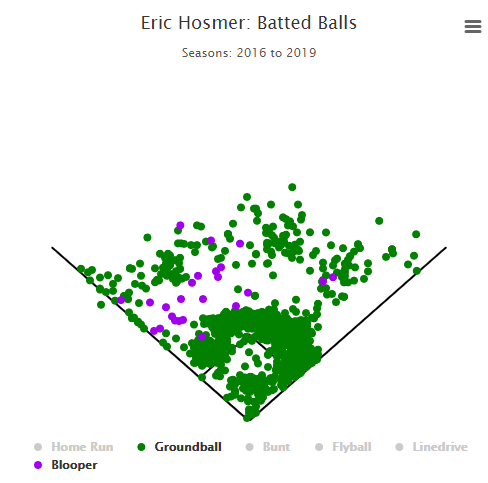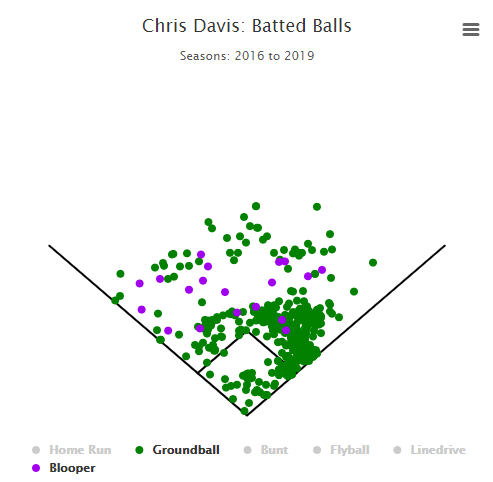The Dodgers Get Shifty
Eric Hosmer is a hard man to shift against. Though he fits the two main criteria for an overshift (namely: he’s left-handed and plays baseball), that’s where his list as an ideal candidate ends. If ever anyone was going to poke a groundball the opposite way, it would be Hosmer — his groundball rate is perennially among the league’s highest, and he hits a fair number of them to the opposite field. Teams generally agree — he’s faced a shift in fewer than half of his bases-empty plate appearances this year, and only 40.7% overall. Both place him in the bottom third of left-handed batters when it comes to the defensive alignment.
You don’t have to dig into his groundball numbers for long to work out why. The reasoning behind a shift is simple; hitters pull groundballs. League-wide, a whopping 55.5% of groundballs have been pulled, against only 12.1% hit the opposite way. The split is the same regardless of handedness, but first base is conveniently located on the lefty pull side of the field, which makes shifting a left-handed batter a high-percentage move.
For some reason, though, Hosmer doesn’t fit that mold. In 2019, he’s pulled only 46.4% of his groundballs, almost exactly equivalent to his career average of 46.3%. He’s at 16.3% opposite-field groundballs for his career over a whopping 2,263 grounders. His pull rate is in the bottom 20% of batters this year, and was in the bottom 3% last year, the bottom 10% two years ago, the bottom 15% for his career — you get the idea.
This isn’t to say there’s no merit to shifting against Hosmer — you’d need a more detailed mapping of infielder speeds and groundball exit velocity to work the math out perfectly. But look at his groundball (and blooper) distribution from 2016 to 2019 and tell me you want to shift against this:

The density is high across the board (Hosmer hits a lot of groundballs), but he sprays them. Compare that to Chris Davis, who is always one of the most-shifted players in baseball:

Now, after all that setup, here’s the punchline: the Dodgers shifted against Hosmer Monday night. We just got through talking about how hard it is to shift on Hosmer, and one of the smartest teams in the league put a guy in short right field, the classic overshift position:

After about a second, though, a sense of unease sets in. Wait, where’s the right fielder? Is he that far over to the line? Is that him in center, with a heavy opposite-field shift in the outfield? Nope — he was playing the short right position. Take a look at this modified five-man infield in all its glory:

This shift raises some fundamental questions about why and how teams shift. The intuitive math of a shift works pretty well when we’re just talking about moving infielders around; some balls that would previously be outs become singles, and some balls that would previously be singles become outs. As long as the realigned defense fields more balls than the standard one would, it’s all gravy.
Playing without a right fielder is a different game entirely. Now you’re turning some balls (hard grounders, bloopers, and low line drives to right) into outs, but instead of turning grounders to third base into singles, you’re turning basically any pulled fly ball into a double. If Hosmer puts it in the air to right, a Dodger probably isn’t getting to it.
How much worse for the pitching team is a double compared to a single? Well, in this specific situation, teams have scored 0.566 runs with a man on first and one out so far in 2019. With a man on second and one out, that number jumps to 0.714 runs. The extra base isn’t huge, but it’s not negligible.
In truth, the difference is slightly different than that. The alignment doesn’t change a single to a double — it turns some outs into doubles and some singles into outs relative to a “normal” shift. The difference between an out and a single is .45 runs of expectation, while the difference between an out and a double is .60 runs — you need to prevent four singles for every three doubles you allow. Put another way, if the situation played out 20 times, the defense should be indifferent between allowing nine doubles and 11 outs, and allowing 12 singles and eight outs.
Now that we’ve done the math on why to use this odd shift, let’s decide if it’s worth it here. If there’s anyone this calculation would make sense for, it’s Hosmer. As an extreme groundball hitter who also hits a lot of grounders the other way, he hits a lot of balls that would become singles if the third baseman shifted away. At the same time, he hits few fly balls, and fewer still to the pull side (he has a 20.4% pull rate on line drives and fly balls for his career).
At a baseline level, the math is pretty clean. For every hundred balls in play, Hosmer hits 54.5 grounders, 25.4 fly balls, and 20.1 line drives. Plug in their respective directional rates, and that works out to 8.8 opposite-field grounders, 3.9 right field fly balls, and 5.4 right field line drives. Right off the top, the math doesn’t work — you can turn 8.8 singles into outs by having a third baseman or 9.4 doubles into outs by having a right fielder.
Neither of these assumptions makes sense, though. Some of those pulled fly balls are going to become home runs, for one thing, and you don’t get any extra points for having your right fielder watch a home run from up close rather than from shallow right field. 27.6% of Hosmer’s pulled fly balls go for homers, and another 11.7% for doubles or triples. Another 8% never leave the infield, which gets us down to two fly ball outs that turn from outs to doubles. The number is actually a bit smaller still, since he hits the occasional fly ball single, but we’ll leave that out of the math to make it easier.
Not all the line drives become outs normally either. Almost half, in fact, become singles, which we’ll upgrade to doubles. Another 22% go for extra bases, which we’ll leave unchanged. Changing a single into a double only costs the defense 25% as much as changing an out into a double. After accounting for that and the extra bases, playing without a right fielder is equivalent to turning 2.4 line drive outs into doubles.
On the other side of the ledger, not every opposite field groundball turns from a guaranteed out into a single by moving the third baseman. For his career, Hosmer is batting .425 on opposite-field groundballs with no shift on, which means only about 5.1 of these ground balls were going to be outs anyway. Teams are probably at least shading, which the Dodgers don’t have to do in their alignment, but still. If we’re taking credit away on one side, we need to do the same on the other as well.
There are other adjustments you could (and probably should) make — some line drives will get caught by the short fielder, some fly balls that leave the infield could be caught by the shaded center fielder, and some will be shallow enough that the short fielder will have a play on them. Still, the math is really close — it’s the right or wrong decision to shift this way by a narrow margin — 4.3 doubles against 5.1 singles.
We’ve left one thing out, though, and it’s an incredibly important thing. Adam Kolarek was pitching to Hosmer, and Kolarek is no ordinary pitcher. First, he’s left handed, and that matters. Hosmer hits slightly more grounders against lefties, and pulls fewer line drives and fly balls. That already tilts the math in favor of removing the right fielder.
More importantly, Kolarek is an extreme groundball pitcher. His 2.8 GB/FB ratio is the 12th-highest for any reliever in his time in the majors, and he’s fifth in that category this year; a whopping 64.9% of contact against him has been on the ground. That number balloons to 73.6% against lefty batters. Essentially, lefties batting against Kolarek almost always hit grounders, and Hosmer almost always hits grounders anyway.
To get a sense of how those two things stack, I ran a quick(ish) test. I took all of Hosmer’s career batted balls and separated them into six groups — high, medium, and low-grounder pitchers from each side of the plate. I defined high, medium, and low by the bottom third, middle third, and upper third of overall career groundball rates. As you can see, left-handed groundball pitchers induce an absolute ton of grounders against Hosmer:
| Type | Low-GB% | Mid-GB% | High-GB% |
|---|---|---|---|
| LHP | 53.5% | 57.3% | 66.8% |
| RHP | 44.6% | 53.6% | 58.8% |
I’ll save you the math this time — I plugged Hosmer’s high-grounder lefty batted ball splits and pull rates in, and the math comes down to 5.2 groundball singles against 2.8 doubles. It’s no longer too close to call — the right fielder is less valuable than the third baseman in this batter-pitcher matchup. Every hundred balls in play, the Dodgers were saving about .60 runs, by my math, with their inventive shift.
That’s obviously very little, but it understates the case — we’re looking at the top third of lefty groundball pitchers, whereas Kolarek is one of the best of the best. If we look at the top 10% instead of the top 33%, Hosmer’s groundball rate climbs to 74%, albeit over only 136 balls in play. Against the top 5%, he’s at 82.5% over an even skimpier 63 events. If the matchup is truly that extreme, the Dodgers could be saving as many as two runs per hundred balls in play — still small, but worth doing.
Would life be good enough to show us one of those two runs, a bloop double or an opposite-field groundball that the Dodgers converted to an out? Well:
Ugh. Ugh! All that math and he struck out? Struck out looking on a pitch outside of the strike zone? There’s no justice in this game. Eric, know that I’m as upset with the umpire as you are:
We’ll never know if this tactic would work over the long run. Eric Hosmer and Adam Kolarek won’t face each other a hundred times, let alone the thousands we’d want for a clean answer. Heck, you probably can’t shift this way with men on base, so many Kolarek-Hosmer standoffs wouldn’t merit such a weird shift. Still, what a neat baseball oddity. The Dodgers are trying weird things, rare things, to save little fractions of a run. What more could I, the numbers-loving baseball analyst, ask for?
Ben is a writer at FanGraphs. He can be found on Bluesky @benclemens.

This was a neat read, Ben. I am continually impressed at how teams are attempting to lean into batted ball manipulation a la the Athletics and their pop-ups optimized squad.
The OBP revolution was real and it worked for obvious reasons. This has nothing to do with that.